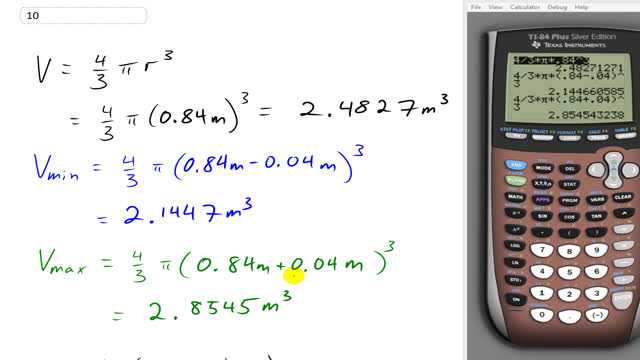
What, roughly, is the percent uncertainty in the volume of a spherical beach ball of radius ?

In order to watch this solution you need to have a subscription.
This is Giancoli Answers with Mr. Dychko. Our strategy for estimating uncertainty in this case will be to assume that our measurement of 0.84 meters is at its maximum— 0.84 plus the uncertainty of 0.04 meters— and what volume would we get in that case and that would be 2.8545 cubic meters. And then we'll consider what minimum volume is possible supposing this 0.84 meters was in fact reduced by this uncertainty of 0.04 and in that case we get 2.1447 cubic meters. And we'll find the difference between the max and the min and divide by 2 and that gives us the spread that we would expect around this calculated volume using just 0.84 meters and then we'll figure out what the percent uncertainty is in that case. So here are the calculations on our calculator— I'm showing the straightforward volume calculation to begin with— 4/3 times π times 0.84 meters cubed of 2.4827 cubic meters and then the minimum volume that would be possible within this uncertainty and then the maximum volume that would be possible and then take the difference and also divide by 2 and we get 0.3549 cubic meters is our absolute uncertainty or at least an estimate of it anyhow and then we'll figure out what percentage that is of our calculated volume and that calculation is here. And that is 0.1429 and we only need one significant figure in an error estimate and so we'll have 0.1 percent is our percent uncertainty in the volume.
Should it not be 14.29% if you are multiplying by 100 to get percent?
Hi gheewala_jen4u, you're quite right, and thank you for spotting that. The final answer should be multiplied by 100, and since this is an error, for which only 1 significant figure is normally appropriate, we can round that to 10%.
Thanks again,
Mr. Dychko
Why do we round to one sig fig? Would it not be 2 sig figs? So 14%?
Thanks for the question harringtonwarriorfitness. One significant figure in an error is typical, two is also OK I suppose, and I've never seen three. Consider how an error is different from a measurement: an error is something that is estimated. An error is never measured. Since an error isn't measured, there's nothing you can do to improve its precision. Since an error is only estimated, that means it can never be very precise, and one significant figure is the usual rule of thumb for errors (or maybe two).
Hope that helps,
Mr. Dychko
Thank you for the fast response! So would 10% and 14% both correct?
Yes, exactly, !0% and 14% would both be correct. If you're want to be extra careful, consider asking the person marking your work what their preference is. Maybe they want you to demonstrate your understanding of the fact that an error is merely estimated, and they prefer only 1 significant figure? Or, maybe rounding to only 1 sig fig hides the fact that you did the error estimate calculation correctly, in which case 2 sig figs is better... It's a judgment call, but both 1 or 2 sig figs should be accepted.
Best wishes with your studies,
Mr. Dychko
Why don't we divide the uncertainty by the spherical volume? That's what they did in the examples, but now you need to do extra steps? I understand the reasoning for it, but I don't understand what in this question makes me think I need to do it this way as opposed to just dividing the uncertainty by the volume.
I have the same question as candidjay before me
Hi johnqhunter, that's a good question, especially since someone else also asked. I agree with you that percent uncertainty is the absolute uncertainty divided by the quantity (times 100 to get a percent). I'm not sure what you're proposing as an alternative to what's in the video, but as a guess, are you suggesting to divide the uncertainty in the radius by the volume? That won't work since you need to divide the uncertainty in the volume by the volume, not the uncertainty in the radius by the volume. The work in the video is done to estimate the uncertainty in the volume so that we can divide the volume into that. A clue that you might be mixing things up is that units for percent uncertainty are always dimensionless - in this case uncertainty in volume is $m^3$ divided by volume, which also is $m^3$, which cancel giving a dimensionless fraction with no units. If you were to divide uncertainty in radius, with units of $m$ by volume $m^3$, you'd be left with peculiar units of $m^{-2}$, which is the clue that something's not right.
All the best,
Shaun
Why do you round the number to 4th decimal place, was it alright if i rounded it to 2nd or 3th decimal place ? Is there any rule here or it's up to us to decide ?